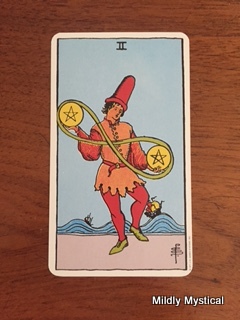I recently took part in a Tarot workshop called “Exploring the Tarot – A Tool for Insight and Contemplation,” led by Brian Relph. I expected it to be an interesting intellectual exercise. The images on the cards have spoken to people for hundreds of years, and I looked forward to delving into their symbolic meanings. But the workshop turned out to be an experience not primarily of the head, but of the heart.
The images came to life as they addressed the ongoing concerns of the workshop participants. We considered the feelings that arose from looking at a card in response to questions such as “What phase of life am I in now, and what awareness would be helpful to me?” or “What supports me in meeting this particular challenge?” Wisdom and insight emerged from considering how the energy and meaning of a card intersected with a particular aspect of life.
Having worked extensively with dreams, exploring images from the Tarot felt somewhat familiar to me. It was noticing that these images sometimes turn up in dream work that inspired me to learn more about the Tarot. These shared archetypal images represent universal patterns of human existence across time and throughout the world. We manifest these archetypes in our individual lives, but each of us lives them out in our own unique ways. The meaning of a dream element, like the meaning of a Tarot image, comes from the intersection of the universal and the particular.
There is ancient Judeo-Christian precedent for seeing dreams as messages from the divine. In both the Old and New Testament, dreams are a way of receiving heavenly insight and guidance. While it may not be common these days for Christians to work dreams as part of their spiritual life, it is part of our spiritual lineage. Tarot, however, is an unfamiliar tool in the Christian theological world view. We may believe that divine wisdom is available all the time through prayer, but if that wisdom arrives in an unfamiliar way it is often seen as suspect. It’s simpler and easier to reject the unfamiliar.
Yet people of faith find many different ways of becoming ever more aware of and attuned to the divine. We rely on the spiritual structures we put in place to encounter the help and guidance that are available to us all the time. Some look for insight conveyed through scripture or in worship. Some invoke the help and protection of the saints, carrying a St. Christopher medal when traveling, for example. Wisdom visits us through signs in the natural world, or a book that suddenly calls for attention, or the sudden resonance within a conversation.
Working with the Tarot is another way of paying attention. It’s not about fortune-telling. This misconception about (or misuse of) the Tarot as if it were for predicting events is similar to a common misunderstanding about the Old Testament prophets. Isaiah and Jeremiah and others were not trying to foretell events that would occur hundreds of years into the future. They were speaking clearly and directly about Israel’s current situation. The prophets were able to do this because they were deeply connected to the wisdom of the divine, able to anticipate the outcome of Israel’s ongoing actions. Yet when later generations look back at their divinely inspired words for guidance, their insights are so keen they offer a lens for interpreting current-day experience and seem to anticipate future events.
In processing my experience of the Tarot with my spiritual director, he asked where I thought the wisdom was coming from, or what it was I encountered through working with the images. The best answer I have for the time being is that the archetypes depicted on the cards open the door to a wisdom that comes from deep within. Yet this insight originates beyond my individual experience; it taps into the universal experience that connects us all. It’s what Carl Jung called the collective unconscious, or what is recognized in the greeting Namaste—the divine in me acknowledging the divine in you. It is the Source of all life, available in every moment, offering itself to us if we will just pay attention.

